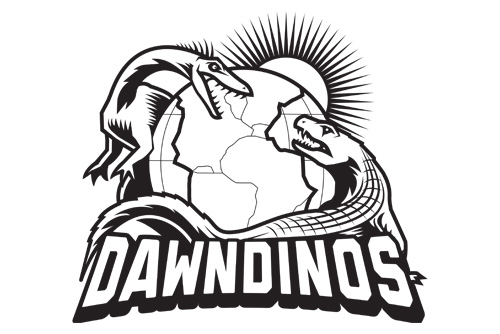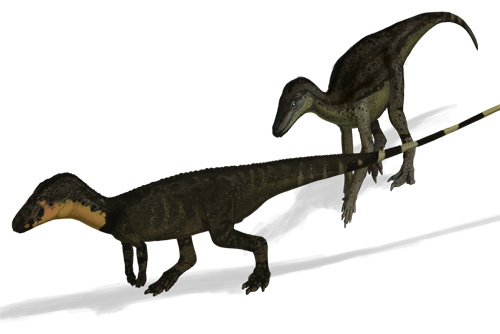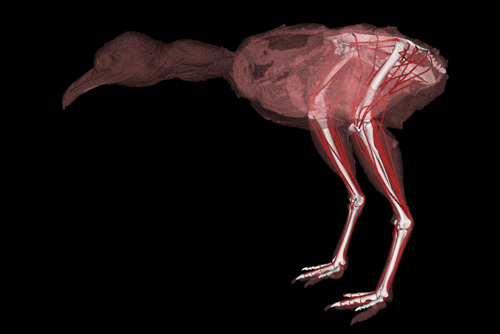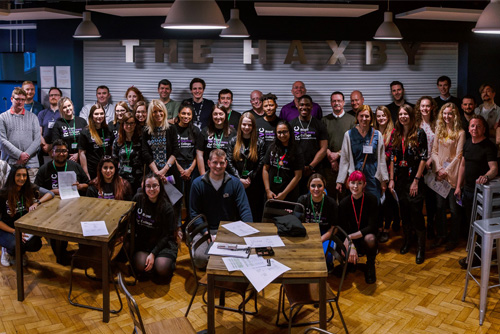
DAWNDINOS: Testing the locomotor superiority hypothesis for early dinosaurs
DAWNDINOS is in the final year of a five-year research programme studying the dawn of the age of the dinosaurs. This ERC Advanced Investigator grant-funded project, awarded to Prof. John Hutchinson, seeks to unify evolutionary and biomechanical research by achieving a “functional synthesis” in evolution that causally links the anatomy of extinct dinosaurs and their relatives (archosaurs; “ruling reptiles”) to actual performance.

Challenge
In this study we are testing the old “locomotor superiority” hypothesis that early, bipedal dinosaurs evolved advantages in their locomotor performance over other Late Triassic archosaurs. This hypothesis was first proposed to explain what made dinosaurs distinct from other Triassic species, perhaps aiding their survival into the Jurassic period. However, the hypothesis remains untested or unfairly dismissed.
The Dawndinos research is directly testing this question for the first time. In the first half of the study, extant archosaurs Nile crocodiles Crocodylus niloticus) and tinamou birds (Eudromia elegans) allowed us to experimentally measure key factors (such as 3D skeletal motions and limb forces) that are involved in five behaviours: walking, running, jumping, standing up, and turning. We then used biomechanical computer simulations to estimate how these behaviours were achieved and estimate performance determinants we cannot measure, such as muscle forces or lengths and consider whether more extreme behaviours (e.g., faster speeds) might still have been feasible but not observed. This refined our simulations by testing major assumptions, and is validating them for studying extinct archosaurs, thereby overcoming the obstacle that has long limited researchers to qualitative, subjective morphological inferences of performance.
Now, in the last few months of our study, we are using our simulation tools to model at least eleven Triassic/early Jurassic archosaurs and predict how they may have moved, and to compare how their performance in the five behaviours related to locomotor traits, testing if the results fit expected patterns for “locomotor superiority.”

Solution
This study pushes the frontiers of experimental and computational analysis of movement by combining the best measurements of performance with the best digital tools, to predict how form and function are coordinated to achieve maximal athletic behaviours in a given species. Rigorous, integrative analyses will move the field of evolutionary biomechanics forward, enabling new inquiries into how behaviour relates to underlying traits or even palaeoecology, environments, biogeography, biotic diversity, disparity or other factors. Previous studies of crocodylian and avian locomotion were focused mainly on American alligators and galliforms (chickens, guineafowl and kin; poultry). We have added valuable new datasets on distantly related species (Nile crocodiles and elegant-crested tinamous) that broaden our perspective on the ways that living crocodiles and birds move.

Impact
- Our research will advance the study of the evolution of the vertebrate musculoskeletal system during the Triassic-Jurassic transition, which had massive impact on future evolution on land.
- It will contribute to the field of evolutionary biomechanics as it pushes the frontiers of experimental and computational analysis of locomotor performance using modern digital tools and Increasingly sophisticated computer software, including OpenSim http://opensim.stanford.edu, to predict how form and function are coordinated to produce movement.
- Cutting-edge gait analysis techniques, including XROMM, electromyography and computer simulations will measure or estimate parameters that otherwise might only be measurable invasively, if at all.
- The advancement in the use of computer simulation methods will ultimately enhance our understanding of how animals work, leading to improvements in clinical applications to animals and human studies in a wide array of fields including orthopaedics, prosthetics, medical and veterinary care and robotics.
Partners
The study has benefited from a large team of scientific advisors and collaborators involved in diverse aspects of this project. Including Delyle Polet, Ashleigh Wiseman, James Charles, Phil Morris, François Clarac. Previous members of Dawndinos team include Vivian Allen, Andrew Cuff, Peter Bishop, Romain PIntore and Emily Keeble and can be found on the Collaborators page of the Dawndinos website.
Publications

News/in the media
Professor John Hutchinson has done a number of interviews on Dawndinos research for the BBC including the “Earth’s Earliest Life” Science programme on BBC Radio 4, and previously BBC 2 TV documentaries with Chris Packham and Sir David Attenborough. He has featured on the I Know Dinosaurs ‘The Big Dinosaur Podcast’ talking about the project and other dinosaur related research and also engaged with 8th Grade students in the US through a series of five ‘Skype the Scientist’ sessions.
The DAWNDINOS team has delivered a wide range of project related outreach activities through our extensive science engagement programme, details of which can be found on the activities and outreach pages of our website and include RVC open days, summer schools and student visits to the Structure and Motion Lab, the 2019 ‘Dawndinos Night at the Vet College' event to celebrate National Biomechanics Day and our Triassic Vertebrate Palaeontology Meetup conference (online) in May 2021.
Our outreach work with schools is of particular note as dinosaur palaeontology provides a strong basis for increasing understanding and interest in STEM topics. In 2017 the Dawndinos team linked up with the City of London Academy and delivered a ‘science through art’ after-school outreach project. The project included a series of five dinosaur/art club sessions for students aged 11-18 years. It was closely linked to DAWNDINOS scientific research, dinosaur evolution, and presented in a workshop format through different art-based activities.
As well as palaeontology, three-dimensional digital and physical modelling appeals to students for its visually intuitive and technological aspect and can convey a wide variety of STEM concepts of varying degrees of complexity. We introduced these ideas at our school-based science ‘dinosaur club’ at a local secondary school, Onslow St Audrey’s, in Hatfield (Nov/Dec 2018 & 2019) in five, 1-hour sessions. We covered our archosaurian evolutionary biomechanics Dawndinos research and introduced students to major concepts in morphology (anatomy), showing how morphology is central to the study of organisms, biomechanics, behaviour, ecosystems and evolution. In February 2021 we successfully adapted this “on site, in-person” programme to an online format for students at Chancellor’s School in Brookman’s Park which was very well received with excellent feedback from the students.
